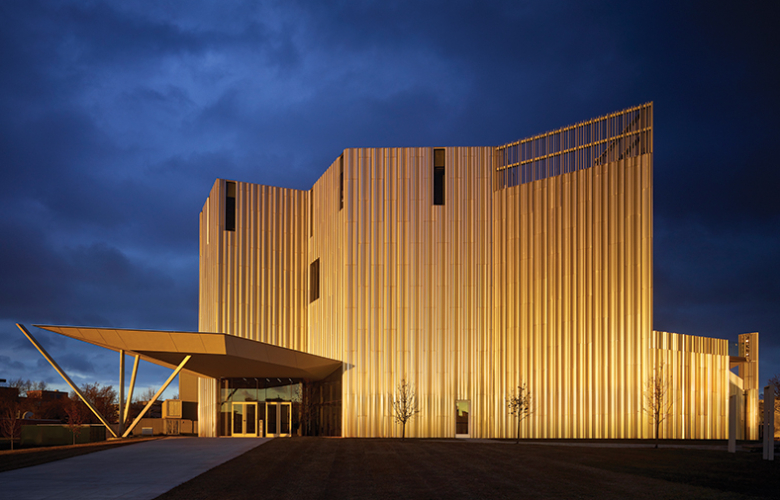Art Gensler, FAIA, 1935–2021
M. Arthur “Art” Gensler Jr. died on Monday, May 10. His six-decade career was marked by championing a culture of mutual trust, respect, empathy, and team spirit, culminating in the “one-firm firm” philosophy. Art believed in building a constellation of stars rather than focusing on individual accomplishments. He also put forth the then-novel idea that design is an experience-first endeavor, focused on the user journey in a building. His “inside-out” philosophy is the basis of the human-experience-centric approach that characterizes the firm’s design ethos to this day. He also believed architecture and design professionals have a responsibility to lead on environmental challenges.
In 1965, Art founded his eponymous firm in San Francisco with three people, including his wife, Drucilla (Drue) Cortell Gensler, and helped grow it into the world’s largest design firm, now with 46 locations and thousands of employees. He is also credited with establishing an arena of work that fell below the radar for many architects: space planning and interiors. Early in his career, Art recognized the need for a new architectural discipline that came to be known as tenant development. Beginning with the Alcoa Building in San Francisco, the firm created the programming practices that have become the framework for interior architectural projects throughout the profession. He brought interior design to a new level of professionalism and helped clients understand its value within commercial real estate.
Probably less known is Art’s impact on the practice in the state of Texas, a place that was special to him. He first arrived in Houston to begin work on the Pennzoil headquarters for Hines. He delivered his unique interiors approach for the energy corporation, while the building’s core and shell was designed by Philip Johnson. This project was the start of a decades-long relationship with Gerald D. Hines.
Jerry Lea, executive vice president for Hines, notes: “Art changed the architecture of buildings by shifting the design to focus on the exterior appearance and entrance lobby, as well as the interiors. He paid close attention to floorplate efficiency, proximity to daylight, and the overall flexibility and usability of each floor to create a healthier and more productive work environment for owners, tenants, and their employees.”
The Pennzoil project was also the catalyst for opening the Gensler Houston office in 1972 — the second, after San Francisco. This office, which called the Pennzoil building home for more than 40 years, is an anchor in the firm and planted the seeds for the Dallas (1997), Austin (2007), and San Antonio (2018) offices.
With Hines, Art and Gensler developed the Texas-based concept of the office of the future in the 1990s. In this integrated and collaborative process, Art not only advanced the evolution of interior architecture and design, but also introduced early ideas of sustainability that led to the creation of LEED standards and core components of the U.S. Green Building Council. This includes a core and shell rating system that was readily embraced by developers and building owners, which resulted in more sustainably designed buildings in Texas and throughout the country.
Client relationships were a cornerstone for Art and for Gensler’s success in Texas. He was masterful in building strong bonds with clients, such as with Jerry Jones when the firm designed the Cowboys’ world headquarters and practice facility at The Star in Frisco.
My professional experience shaped by Art Gensler actually spans more than 25 years. I am one of Gensler’s principals and actually spent the first half of my career working with the Gensler team as a client. At The University of Texas Health Science Center at Houston, his team was invaluable in delivering fairly straightforward office, lab, and classroom improvements across the Texas Medical Center campus, until the fateful tropical storm Allison made a mess. Not only did Art and the Gensler regional leaders appear overnight to assist us in our recovery and in dealing with FEMA, but Art maintained regular contact over the years of recovery to see how we were faring.
Following my departure as the campus architect, I arrived at Gensler to lead the firm-wide sustainability and resilience focus. Art was instrumental in understanding the implications of this design delivery for every project across the globe. He would regularly use the analogy of a rubber band in discussing the need for the Gensler teams to “stretch” the client to new green opportunities, but not overstretch them; he was an invaluable coach for both everyday projects and the occasional global transformation mindset. One such project might have transformed parts of the Texas coast into a global seawater agricultural economic and sustainable area of innovation. Art was the leader of the effort in so many ways, from strategic thinking to worrying about tactical issues of local partnerships.
To date, the Texas offices have designed several thousand projects locally, totaling upwards of 60 million square feet. The work covers a vast range of project types, including aviation, large and small office buildings, hospitality, civic buildings and government facilities, houses of worship, libraries, retail and restaurants, schools, and sports venues.
Art was also a passionate supporter of education and culture, and of bringing up the next generation of designers. Judy Pesek, regional managing principal for Gensler’s South Central region, which covers Texas, recalls how Art would always make time to visit with students taking her interior design class at The University of Texas at Austin. “It was such a treat for them,” she says, “and some of those students are employees today.”
Pesek also invited Art to join her at client meetings. She recalls one he attended with an interior designer who had transitioned to the brokerage side: “I did not have time to tell her that Art would be there. To say she was surprised is an understatement. Art was Art: a humble force. After lunch, he gave her his business card, and she shyly asked, ‘Would you mind autographing this?’ When we got in the car to go back to the office, Art simply said, ‘Gosh, these people in Texas sure are friendly!’”
In 2015, Art wrote “Art’s Principles: 50 Years of Hard-Learned Lessons in Building a World-Class Professional Services Firm.” It offers today’s young entrepreneurs his well-tested ideas on leadership, talent acquisition, operations, and creative strategies.
Throughout his career, Art never lost sight of the inspiration that drives our profession, as expressed in a letter to his Gensler family:
Some of my greatest joy has come from walking through the studios as teams engage in intense collaboration, attending presentations (internal and external) of our emerging areas of expertise and of Gensler design excellence, listening to clients and others praise our work and our commitment, discovering inspired avenues for giving back to our communities, and watching new team members embrace the strong, vibrant Gensler culture. We enjoy a team spirit and a focus on excellence that is not only notable, but also sustainable. We are well positioned to continue our success no matter what challenges may lie in our path.
Rives Taylor, FAIA, is a principal in Gensler’s Houston office and firm-wide design resilience co-leader.
Also from this issue








